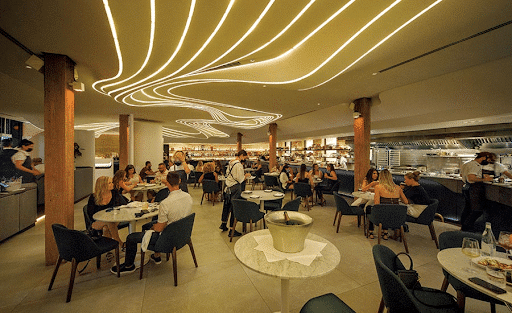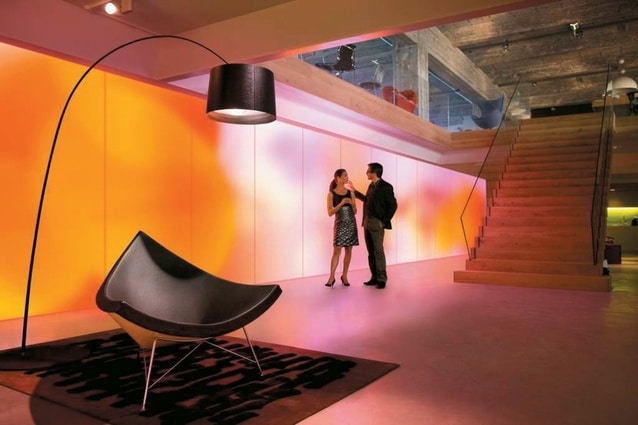What is Architectural Lighting?
Architectural lighting refers to the perfect balance of style and function; the meeting of the artist and the engineer to create a space that’s both convenient and impossible to ignore. Whether highlighting the grandeur of a historic structure or accentuating the sleek lines of a modern building, architectural lighting plays a vital role in bringing a building to life and creating a memorable impression on those who experience it. Through careful planning and execution, architectural lighting can transform any building into a work of art that leaves a lasting effect on guests.
The Concepts Behind Architectural Lighting Design
Aesthetics in Commercial Lighting Design
The right lighting can transform a space, enhance its features, and make it more appealing. By using different lighting techniques such as highlighting, shadowing, and layering, architectural lighting can be used to craft the right mood for a space.
Lighting should be used strategically to highlight key areas or products and create a welcoming atmosphere. It’s also important to choose fixtures that complement the overall design of the space, and to pay attention to color temperature and light quality to ensure a comfortable and inviting ambiance.
Functional Architecture Lighting Design
Functionality is the most important concept in architectural lighting design, as it’s essential for creating a safe and effective environment for occupants. The primary goal of architectural lighting is to provide adequate illumination for a specific task or activity, while also complementing the overall design of the space. The lighting system should be designed to serve its intended purpose, whether it’s for work, relaxation, or entertainment.
Lighting fixtures should be selected based on the type of space being lit and the specific requirements of the activity. This can include considerations such as color temperature, brightness, and the directionality of the light.
Architecture Light Efficiency
Efficiency is a crucial aspect of architectural lighting design. A lighting system that is efficient provides the right amount of light for the intended purpose, while consuming the least amount of energy and saving on utility costs.
Energy-efficient lighting not only helps to reduce operating costs but also supports environmental sustainability. Nowadays, LEDs are the standard. With their energy-efficiency and lifespan of up to 25,000 hours, as well as the wide range of adjustable features they provide such as adjustable color temperature, dimming options, and smart home integration, they’re the most attractive option on the market.
Best Uses of Architectural Lighting Design in Commercial Spaces
Restaurant Lighting
Quality lighting design plays a vital role in creating a successful and memorable dining experience for restaurant patrons. Effective lighting design can enhance the atmosphere of a restaurant, highlight key design elements, create a comfortable and inviting environment for customers, and it can even affect the taste of food.

High-quality lighting design in restaurants involves a few key considerations, such as the type of cuisine, the desired mood, and the restaurant’s branding. Lighting fixtures should be chosen based on their ability to highlight the unique features of the space and create a sense of warmth and intimacy.
Additionally, the color temperature, brightness, and directionality of the lighting should be carefully considered to create the desired ambiance. For example, warm lighting is calming and creates a more intimate experience, while cool lighting can be energizing for a more social environment. Working with a professional lighting designer can help to ensure that the lighting design meets your restaurant’s specific needs and contributes to a successful dining experience.
Hotel Lighting
Quality lighting design is essential in creating a welcoming and comfortable atmosphere in hotels. It can impact guests’ overall experience, satisfaction with their stay, and even their behavior and mood.

Achieving effective lighting design in hotels involves several factors, such as the type of hotel, understanding the purpose of the space, and the hotel’s branding. Lighting fixtures should be selected based on their ability to highlight the unique features of the space, create a sense of comfort and intimacy, and enhance the guest experience.
Convenience, efficiency and sustainability, as well as color temperature, brightness, and directionality of the lighting should also be considered and catered to the function of each space.
Retail Shop Lighting
Retail shops use lighting to enhance the shopping experience for customers. Lighting can help drive sales by highlighting specific products or displays, create an inviting atmosphere, and guide customers through the space. In order to achieve effective retail lighting there are several key considerations you should make, such as the type of products being sold, the desired shopping experience, and your brand’s identity.
 Lighting fixtures should be selected based on their ability to highlight product features and create a sense of excitement and intrigue. The color temperature, brightness, and directionality of the lighting should also be carefully considered to influence your buyers’ behavior. Flexible lighting options are also available, allowing you to adjust your lighting for changes in merchandise and displays.
Lighting fixtures should be selected based on their ability to highlight product features and create a sense of excitement and intrigue. The color temperature, brightness, and directionality of the lighting should also be carefully considered to influence your buyers’ behavior. Flexible lighting options are also available, allowing you to adjust your lighting for changes in merchandise and displays.
Summary
Architectural lighting is an essential element of commercial interior design. Whether it is used in restaurants, hotels, or retail shops, lighting should be aesthetically pleasing, functional, and efficient.
At Solais Lighting Group, we have provided innovative and customizable lighting solutions for all of these types of spaces. For further assistance, contact our team.
